'The story of a weird world I was warned never to tell'
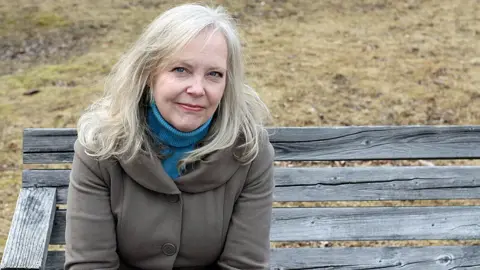 BBC
BBCPauline Dakin's childhood in Canada in the 1970s was full of secrets, disruption and unpleasant surprises. She wasn't allowed to talk about her family life with anyone - and it wasn't until she was 23 that she was told why.
There was always something unusual about Pauline Dakin's family.
"My brother and I would say, 'What do you think is wrong with our family? Why are we so weird?' But that was the mystery that just didn't get answered."
Pauline's parents, Warren and Ruth, had separated when she was five, the summer before she started school. Warren, a successful businessman, was a heavy drinker who could become violent and a point came when Ruth just couldn't take it any more.
When Pauline was seven, Ruth took the children on a holiday to Winnipeg, more than 1,000 miles (1,600km) from their home in Vancouver. But when they arrived Ruth told them they were never going back.
"There was no opportunity to say goodbye, it was just this abrupt, severing of relationships," Pauline says.

When she asked her mother why she had done this, there was never a good explanation.
"She would only say, 'I'm sorry, I can't tell you, when you're older I will tell you.'"
The same thing happened again four years later - this time the family moved to New Brunswick, on Canada's eastern coast.
Apart from this, life was quite normal for Pauline's family - they'd start again and build a new life in a new town. But below the surface Pauline was confused, anxious and falling into depression.
"I knew something bad was happening," she says. "I didn't know what it was, but there was always a sense of something dire that was unspoken."
By the time Pauline was 11 she'd attended six different schools in nearly as many years and had lost touch with her dad.

But another man had come into the family's life, a church minister called Stan Sears. Pauline's mother had met Stan at a support group for the families of alcoholics - Stan was a counsellor there and Ruth had gone to him when she was struggling with Warren's drinking and preparing to leave him.
Both times that Pauline's family had disappeared Stan's family had moved in lockstep with them.
"So whatever had been going on they were part of, I knew that," Pauline says.
Once in New Brunswick, they put down roots. By 1988, at the age of 23, Pauline had graduated from university and was working on a local newspaper in the city of Saint John, when her mother telephoned with an unexpected proposal.
"She said, 'OK, I'm ready to explain all of these strange things that have happened throughout your life.'"

Find out more
Pauline Dakin spoke to Outlook on the BBC World Service
You can listen again here

Pauline was to meet her mother outside a motel halfway between the two cities they were living in. When she arrived, Ruth slipped a note and an empty envelope into Pauline's hands.
The note read: "Don't say anything. Take your jewellery off. Put it in the envelope. I'll explain, just don't talk."
"It was just the most bizarre thing," Pauline remembers. "I thought, 'Who are you? What are you doing?' But I did what she told me."
Her mother took her to a motel room where Pauline was surprised to find Stan Sears waiting for them.
Stan and Ruth told Pauline that for the past 16 years they had been on the run from the mafia and that Pauline's family had been targeted because her father, Warren, had been involved in organised crime. She couldn't wear her jewellery because it needed to be tested for bugs.
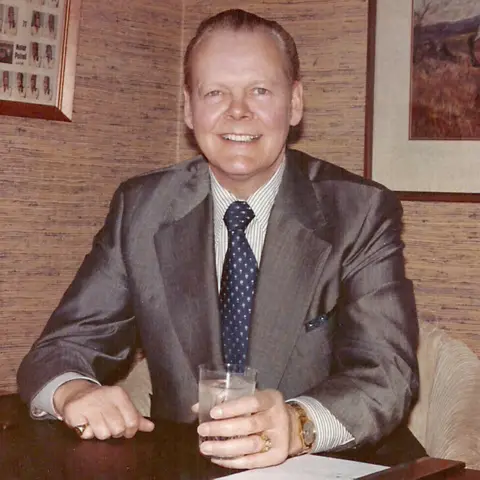
"It was unbelievable," Pauline says. "But I remember a feeling of terror coming over me that this might be something we could never escape."
Stan explained that it had all started after he had counselled a mafia kingpin who wanted to turn his back on his criminal past. When the mob discovered that the man had broken its code of silence and come to Stan for counselling they had assassinated him - and had then come after Stan thinking he probably knew too much.
Later, when Ruth - the embittered ex-wife of a mobster - had started working as a secretary at Stan's church, she too had become a target.
"I was then told that each of us had somebody following us, keeping an eye on us from a distance," Pauline says, "and that there had been many attempts to either kidnap, poison or kill me but that these agents had intervened to keep me safe many times over the years."
As well as this government-sanctioned taskforce, Stan also explained that there were shadowy communities - towns or villages in different parts of the country - where people who'd been targeted by the mafia could go into protective custody. This was known as the "weird world".
After years on the run, Pauline's mother said that she was going to "go inside" for protection. She was going to disappear again.
Stan was already living in one of these communities called Place of Hope, he said, but his wife hadn't wanted to go inside with him, so he was now living there alone and working in this weird world with its agents.

Stan and Ruth told Pauline that this was their chance to finally be together, they had been in love for many years, but they had never been able to act on their feelings.
Pauline was in shock, it was too much to take in.
"I was sick with fear and sadness and it just felt like life was shattering all around me," she says.
Pauline spent that weekend listening to Stan and Ruth's stories, which explained many of the odd things that had happened while she was growing up, like the time she had come home to find her mother throwing away all the food from their fridge.
"The story at the time was that the food had gone bad, but I remember thinking, 'Ketchup and mustard don't go bad, there are things in there that don't go bad quickly. Why would you do that?'"
Stan explained that they had received word that somebody was trying to poison them, so everything had to be thrown away.
And there was the time her family had gone hiking in the middle of the school week and stayed overnight in a mountain cabin. People had been coming after them, Stan explained, and they had to get away for a day or two.
Then there was the day the family had skipped school to go bowling, and the time the children had come home from school and been rushed through the house, told to scrub their feet in the bath and made to wear plastic bags over their socks for the rest of the day.
There was a sinister reason for all of these strange episodes.
"As unbelievable as it sounds there were all these explanations that made pieces that had been so troubling fall into some kind of a pattern, a narrative," Pauline says.
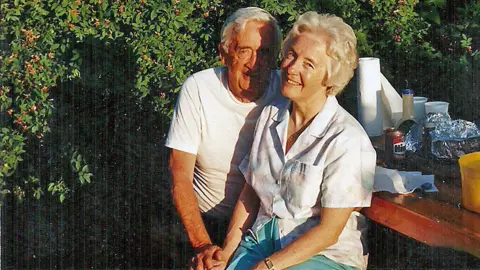
When it was time for Pauline to leave Stan asked if he could put a transmitter on her car to make it easier for the "good guys" to follow her and make sure she was safe. He also gave her a small transistor radio that he said had a broadcast function, so that Pauline could send a call for help.
"He warned me: 'Only use it if your life is really in danger because people will respond and put their life on the line for you.'"
Pauline returned to the home she was renovating with her boyfriend and to her job in the newsroom, but she was struggling to come to terms with what she'd been told and growing more and more fearful by the day.
She was constantly looking over her shoulder for people or cars that might be following her, and became too scared to eat at restaurants in case somebody tried to slip something into her food. She planned escape routes from inside her own home and assumed that her telephone line was bugged.
Over time more and more alarming information came from Stan and Ruth about the weird world, including the news that many people they knew weren't really the people they seemed to be.
"The story was that some people who had been around us during my childhood, who were involved with organised crime, had been picked up - arrested, killed or otherwise disappeared - and then replaced by doubles," Pauline says.
"Sometimes the double was put in place by the 'good guys' and sometimes the double would be put in place by the 'bad guys', so you were never 100% sure whose double it was. It was espionage."
The doubles, Stan explained, spent months studying home videos to learn how to behave convincingly, and used specialist plastic surgeons and make-up artists to perfect their disguises.

You may also be interested in:

Pauline encountered these doubles from time to time. On the day her brother got married, for example, she met her father and her aunt for the first time in years. Both, she was told, were doubles.
"My mother was so upset at that wedding because her sister was supposed to be a double," Pauline recalls. "She kept saying, 'But look at her toes, those are exactly Penny's toes, how could you make somebody else's toes look like that?'"
Pauline remembers looking at her dad that day. He had a nevus - a little overgrowth of cells just over the iris of his eye - how on Earth could it have been replicated, she wondered.
"But when I said that to Stan he said, 'Oh, it's contact lenses and there's prosthetics, and there's this and there's that.' There was always an answer," she says.
Pauline and her mother also received dozens of letters from people inside the weird world - from her father and godfather, for example, who were being held in a top secret prison there, Stan said. The handwriting always looked authentic, and the letters talked about things from their shared past.
They were convincing. "Who on Earth would have time to forge them if they weren't real?" Pauline wondered.

Despite being plagued by doubts, Pauline always had to acknowledge that the two people telling her this incredible story were her mother and Stan - the most trustworthy people she knew.
"It was a crazy story and I did have some challenges believing it," she says. "But if I couldn't trust them, who could I trust?"
Pauline began to feel that her work as a reporter covering school board meetings and town council meetings was irrelevant when her own life was in constant danger. And being sworn to secrecy had placed a gulf between her and her boyfriend, and everyone else in her life.
"I just thought, 'I can't live like this,'" Pauline remembers. She decided that she would go inside with her mother.
Stan told Pauline there was work inside that she could do, that there was a community of good people there that she could be part of. He was building a cottage for himself and her mother and said he could arrange for one to be built for her too. He brought her carpet samples and showed her plans and a photo of the horse that she would have.
Pauline left her job, sold her house and broke up with her boyfriend. She moved to Halifax in Nova Scotia, where she found work and a new home while she and her mother waited for word that it was safe to go inside.
"We were told there had been threats against family members and that if we were to disappear again all hell would rain down on anybody left behind," Pauline says.
"The intelligence gatherers were telling us [through Stan] that the mob had some sense that we might be planning to disappear so they were threatening us. We were always on hold."

Pauline met Kevin who would later become her husband. Stan gave Pauline away on her big day - of course she couldn't invite her real father - and Kevin was allowed in on the dreadful secret. Kevin agreed that he would go inside too.
But the time was never right. By 1993, five years after she had been let into the secret, Pauline's doubts had reached a climax.
"I was at war with myself and I wanted to find some definitive way to prove it right or wrong," she says.
Pauline decided to set up a sting at a time she knew Stan was visiting her mother.
"I called her and said, 'Somebody's broken into my house. What should I do?'"
Pauline's mother replied: "I'll ask our friend and call you back."
Stan had made it clear to Pauline and Ruth that they must never go to the police to report any of the threats and strange goings-on in their lives - the police, he said, couldn't be trusted. If there was ever any trouble they should come to him and he would let them know if he got word of any plots that put them in danger. He had a special contraption implanted in his wallet for receiving messages.
"It would do a Morse code dash and dots message and he would then take out a little notepad and decipher it," Pauline says.
Ruth called Pauline back a few minutes later.
"I was terrified because it was the moment that I was going to get the answer to this horrible quandary that I'd been living with," she says
Ruth said she couldn't talk on the phone, Pauline must go to her house immediately.
Once there Pauline listened, horrified, as Ruth and Stan told her that two people had been picked up just down the street from her house earlier that day, that they had photographs of her, they had been following her and were looking for certain things in her house.
"When she said that I knew the whole thing was a hoax," Pauline says.
"Because there had been no break-in - I made it up.
"That was the moment I knew all of those severed relationships, all of the crazy running, all of the strangeness, it was all a lie."
Pauline was so shell-shocked and angry it was a week before she could confront her mother. When she did, Ruth was horrified and upset - but not because she believed Pauline's accusations against Stan. What worried her was that if Pauline no longer believed the story she would be putting herself in danger.
When Pauline confronted Stan he told her there must have been a mistake; the report about the men who had been picked up after searching her house must have been incorrect. There would be an investigation, he assured her.
"My memory of that night is how sad he was," she says, "I was no longer one of them."
Pauline spent months trying to convince her mother that Stan had been lying to them, while her mother tried to convince Pauline that she was wrong. They reached a stand-off.
"I was furious and resentful and I thought I hated Stan for a long time," Pauline says. "But I finally decided that my mother was not in on this. Stan was making it up, but I just couldn't think why he would have done it."
In her search for an answer, Pauline went to see a psychiatrist.
"I said, 'What do you think this could be? He's clearly not schizophrenic. He does not appear to be psychotic. He's a professional and well respected. People always talk about what a great guy he is, what could be going on?'"
The psychiatrist suggested that it sounded like a case of folie à deux - a syndrome in which symptoms of a delusional belief are transmitted from a dominant personality (Stan), to a less dominant personality (Ruth).
Pauline and her father, Warren, reconnected after many years. But he was by now quite ill with emphysema, and he'd started drinking again.
"I thought about telling him," Pauline says. "But then I thought it would enrage him and that would not be good for him. I just didn't think there was anything to gain from it."
Pauline's relationship with her mother never entirely recovered, though it improved when Pauline started a family.
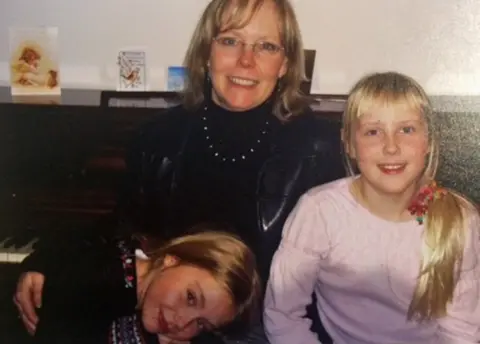
"When I had children things changed," Pauline says, "because they became a focus for all our love."
Ruth developed cancer, which eventually killed her in 2010. But she spent the last nine months of her life living with Pauline.
"I hadn't fully forgiven her at that point, but we both knew that we were out of time to sort through this," Pauline says. "We had to find some place of peace, and eventually we did."
Ruth never stopped believing Stan's story, even after his death when the letters from the weird world dried up, there were no more messages about the activities of the mafia, and there couldn't really be any doubt it had all been a figment of his imagination.
"Shortly before she died she tried to warn me to be careful," Pauline recalls. "I said to her, 'I don't need to be any more careful than anybody else.'"
"And she said, 'Oh, Polly, if you don't believe this how you must've hated me.' And I said, 'No, I didn't hate you. I've been really angry at you, but I do love you.'"
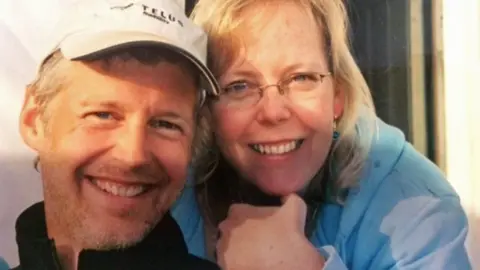
Four years ago, still trying to understand why Stan had concocted the elaborate hoax, Pauline came across an article in a medical journal about a condition called delusional disorder.
"As I read this article I thought, 'This completely describes Stan, somebody who is in every respect normal and competent, but has this crazy delusion,'" she says.
Pauline contacted the author of the paper, a psychiatrist at Harvard University. He was very excited to hear her story. Stan had all the hallmarks of a person with delusional disorder, he said. Another academic, the leading expert on the disorder, agreed.
Finding a reason for what Stan did to her family may have helped Pauline come to terms with her past, but it can't ever repair the damage that he did to their lives.
"I feel very sad for my mother," Pauline says.
"She had such a difficult life and she was vulnerable to Stan, mostly because he was a gentle, caring guy - too bad he had this terrible delusion.
"But I also feel sad for myself and my brother - two little kids whose lives were hijacked."
Pauline Dakin worked for many years for Canada's national broadcaster, CBC, and is now assistant professor at the school of journalism at the University of King's College, Halifax NS. She is the author of Run, Hide, Repeat: A memoir of a fugitive childhood, published by Viking.
All images courtesy of Pauline Dakin, unless stated otherwise.

More from BBC Stories
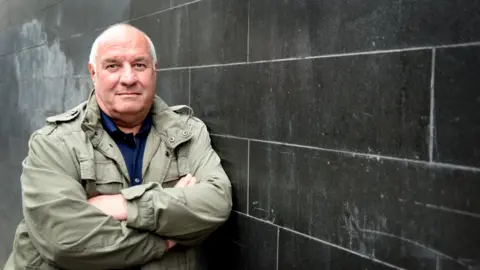
Five years ago a woman walked into a police station in Ozark, Missouri, and claimed her father-in-law was a British fugitive. It was the end of the road for "Fast" Eddie Maher, who had been on the run - with wife and children in tow - for 19 years. How did one of the UK's most wanted men evade capture for so long?

